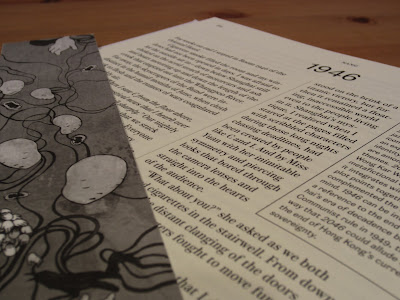NANG 3: Found in Refraction
When I eventually found the time to sit back and read, I decided to read NANG 3 slowly in order to enjoy each individual page. I seldom get the chance to enjoy books so thoroughly. They are much longer, for instance, and each page is impersonal and uniform for the most part. Not so with magazines. The format allow for greater flexibility and variation, and NANG is filled with surprises from the beginning to end.
This is the third issue of a ten-part limited series about film in Asia, and deals specifically with the issue of film and fictitious responses to them. Guest editor Amir Muhammad’s idea, presumably shaped by his experiences as a prolific publisher, was to put together an issue that consisted of much more than straight-up fanfiction. What NANG 3 ended up featuring was a wide range of responses to films in addition to reimagining and embellishing their plotlines. For example the characters, moods, and ways the experience of watching movies informed and shaped the impressions of the viewers/writers. And this being an Amir Muhammad project meant that I would see a lot of familiar names being featured: Ridhwan Saidi, Ted Mahsun, and Julya Oui, for starters.
The package finally arrived in Vancouver nearly two months late, alongside another letter postmarked Japan. I have a fear of losing letters in the mail, and it was a relief to see the package arrive at last. It bore the address of publisher Davide Cazzaro’s lodgings at the Wired Hotel in Tokyo, where the magazine was exhibited at the city’s Art Book Fair. I took my time to read it. There was a lot to process and so many films that I was unfamiliar with. I admit that of all the movies referenced, I only recognized a few of them, namely Ghost in the Shell and Wong Kar-Wai’s loose trilogy [Days of Being Wild, In the Mood for Love, 2046]. The trilogy proved to be a huge influence on my writing during the year that I had spent away university. I eagerly looked up my entry and the associated illustration. Shout’s illustration captured the mood of my short story almost perfectly. A typewriter and an empty hotel, save for two lonely lit lights. Rooms 1946 and 2046 in the Oriental Hotel in post-war Shanghai, awaiting its eventual Liberation by the Communist troops who were marching southward.
My story was peppered with personal connections. In addition to paying homage to 2046’s sense of dislocation and lost love, I wanted to emphasize the semi-autobiographical style of storytelling that its protagonist, played by Tony Leung Chiu-Wai, embodied. My own style of writing and storytelling was very closely tied to my own experiences as much as it was also an exploration of the golden age of Shanghai cinema. I recall sneaking into the lecture hall one January after I lost a potential placement in Haerbin, and wound up watching The Goddess. The film featured a young Ruan Lingyu, Republican China’s most famous film star. Her life was marked by insecurities, failed relationships, and eventually suicide. The tabloid coverage of her death appalled the writer Lu Xun enough that he penned a column denouncing it. “Gossip is a Fearful Thing” found its way into my story. I eventually did spend time in Shanghai, wandering through the colonial remains of the former International Settlement and the French Concession, all the time reading into the city’s storied past. Admittedly it was all romantic and devastating to me after a strange summer before my return to university, and all of this fed into my narrative.
The rest of the magazine was a treat that I split into separate readings: The first on a cold night after the rain, the second was the following morning, tired and trying to make sense of the shifting colour gradients from page to page, and finally I got a chance to revisit the magazine close enough to Christmas when the lights finally came up over City Hall. The other pieces inspired by the trilogy really caught my eye, especially We Are All Memories with its longing, nostalgic tone that evoked recalled Yuddy’s erratic character from Days of Being Wild. But it was also easy to fall in love with the rest of the magazine with its quirks and conventions, and not to mention the beautiful design work that went into every aspect.
I would list Rhythm of Love by Timothy Nakayama, Finding Dumb Photographer by Wiwat Lertwiwatwongsa, and 2 COOL 2 BE W/U by Jayson Antipolo Laniba as my favourites. Michael Phillip Wells’s metafictional take on the artifice of and reality of film, A Chinatown Ghost Story, was an explosion of cinematic fear and magic that ended the collection perfectly. They brought to mind interpretations of different films that I was previously unaware of, and I discovered through this creative refraction the variety of perspectives that emerged from the works of various writers. What was equally wonderful were the illustrations and how well they resonated with the pieces and the films in question.
Taken together, those pieces showcased a multidisciplinary interaction of film, illustration, writing, and graphic design. The magic of cinema is alive and kicking within the pages. NANG 3 was simply a treat and I look forward to 7 more issues.
*


Comments
Post a Comment